
OR
Opinion
No time for complacence – get ready for next wave of COVID- 19
Published On: May 11, 2021 04:47 PM NPT By: Dr Rano Mal Piryani and Dr Ganesh Dangal
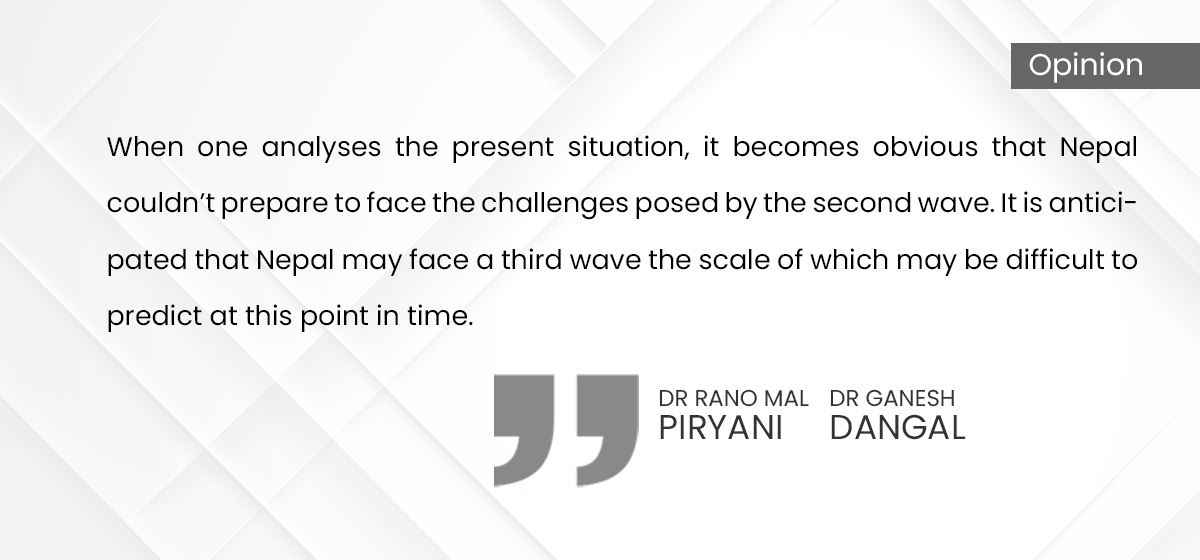
More from Author
When one analyses the present situation, it becomes obvious that Nepal couldn’t prepare to face the challenges posed by the second wave. It is anticipated that Nepal may face a third wave the scale of which may be difficult to predict at this point in time.
Nepal has been facing a colossal burden of the coronavirus disease (COVID-19). As of May 5, 2021, 359,610 new cases of infections and 3,475 deaths have been reported since the first case was reported in January 2020. The calculated death percentage is less than 1% (3475/359610*100=0.997).
If the total number of new cases reported as of May 5, 2021 (359610) (1) is extrapolated on the estimated current population of Nepal as of May 5, 2021 (29,575,016) around 1.21% (359610/29575016*100= 1.2159%) of population of Nepal is reportedly infected.
It is presumed that there might be more people infected then the reported as the number of asymptomatic patients and patients with very mild symptoms might not be reporting to the healthcare facilities. Also, it is evident from the servo prevalence studies, ‘13.9% infection” found in the community level. The infected people may not develop a long-lasting immunity and though very low but chances of re-infections are there.
The second wave is more aggressive in Nepal, than the first wave as far as new reported cases, deaths and severity of the disease are concerned and the trouble people are facing because of their behavior, inappropriate response by the authority and may possibly due to the virulence of the virus/new variant of the virus. Authorities and people were very slow to recognize the threat the virus posed to the country before the beginning of the second wave (Figure 1).
 Daily New cases reported from Nepal as of May 05, 2021
Daily New cases reported from Nepal as of May 05, 2021
Around 80% of the population lives in rural areas in Nepal and the virus has reached every nook and corner of the country. Cases have been reported even from the peaks this time. There is a dearth of health resources especially in the rural areas like intensive care beds, oxygen facility, respiratory supports, medicines and also a shortage of healthcare personals particularly of trained persons to take care of COVID-19 patients. The conditions of isolation and quarantine centers are not conducive mainly in the villages and towns. Hence, people prefer to stay home rather than availing the isolation and quarantine facilities. An overwhelming burden of COVID-19 cases during the second wave has adversely affected the other essential health services. Morbidity and mortality seem to have increased in the second wave of infection compared to the first one (Figure 2).
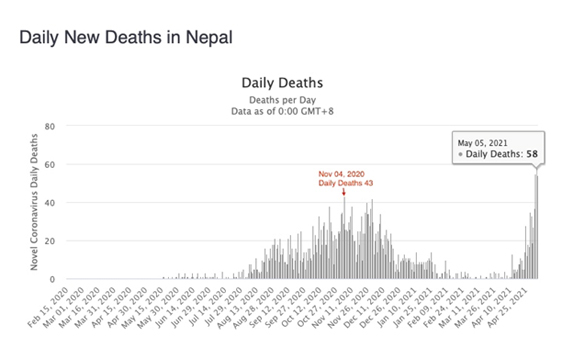 Daily new deaths reported from Nepal as of May 05, 2021
Daily new deaths reported from Nepal as of May 05, 2021
There is no alternate contingency plan to break the chain of transmission. Also, people have not been following the COVID-19 behavior that is essential in containing the infection. A very urgent coordinated action is required to turn the tide in the people’s favor.
The SARS CoV-2 (COVID-19) infection is rapidly spreading at the community level in Nepal. Stopping the spread requires a substantial proportion of the population to be immune. When a majority of the population becomes immune to infectious diseases like COVID-19, then there will be an indirect protection to those who are yet not infected. This is termed as herd protection or herd immunity. This is either achieved when infection reaches the optimal level or two-thirds to three-fourths of the population get immunized with vaccine or by both. Waiting for the people to achieve herd protection from the infection is not wise as it will have a massive impact on the lives of people from every perspective. Immunizing the people with vaccines seems to be a cost-effective strategy.
By April 2021, Nepal administered 2,091,511 doses of COVID-19 vaccines to its population; the majority got only the first dose means they are yet to be fully immunized. It’s a long way before at least two-thirds of the population gets immunized. Even full immunization with the available vaccines does not prevent people from reinfection but it prevents severity of the disease, thereby decreasing the misery of the people, and saving cost incurred on care.
To achieve herd immunity in Nepal, at least 70% of the population has to become immune by infection/vaccination to slow down the rate of infection. This is not an easy task to accomplish in Nepal. Again, this depends on various factors including the new variants of the virus which may bypass the effect of currently available vaccines and peoples’ behavior how they interact with each other. It is said that the more people the virus infects, the more chances it has to mutate, possibly with more virulence.
Experts have already warned of the inevitability of a third wave in neighboring India.
When one analyses the present situation analysis, it becomes obvious that Nepal couldn’t prepare to face the challenges posed by the second wave. It is anticipated that Nepal may face a third wave the scale of which may be difficult to predict at this point in time. The authorities and people may not be more complacent but prepare themselves to face the third wave of the infection. The government needs to relook into the situation seriously and carefully involving all stakeholders and allocate necessary resources to contain the infection in the second wave and face the incoming challenges.
(Dr Piryani is a professor of Pulmonology and Medical Education at Bilawal Medical College, Liaquat University of Medical and Health Sciences, Sindh, Pakistan. Dr Dangal is a professor at the Department of Gynecology and Obstetrics, Kathmandu Model Hospital, Nepal.)
You May Like This
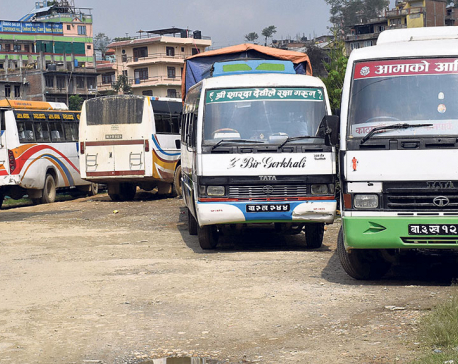
Long-route public transportation services to resume from Sept 17
KATHMANDU, Sept 15: The government has decided to resume long-distance transportation services from September 17. ... Read More...

Let’s stay positive, and fight against suicidal thoughts
Following the current global pandemic, we are gifted with TIME! No hanging out together, no more conventional job patterns, no... Read More...

21 Covid-19 patients escape from quarantine facilities in Dailekh
DAILEKH, June 26: Twenty-one Covid-19 patients who were staying at the Naumule Rural Municipality-based quarantine facilities escaped on Thursday night. Read More...






Just In
- Police report one death in Bhojpur jeep accident
- Nepal faces Bangladesh Red in int'l U-19 Volleyball Championship final
- Nepal Investment Summit: Two organizations sign MoU for PPP cooperation
- Sita Air flight to Ramechhap returns to Kathmandu due to hydraulics issue
- Man found dead in Dhanusha
- Gold prices decreases by Rs 400 per tola
- Ilam-2 by-election: UML candidate Nembang secures over 11,000 votes
- High-voltage power supply causes damage to 60 houses



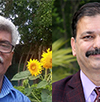






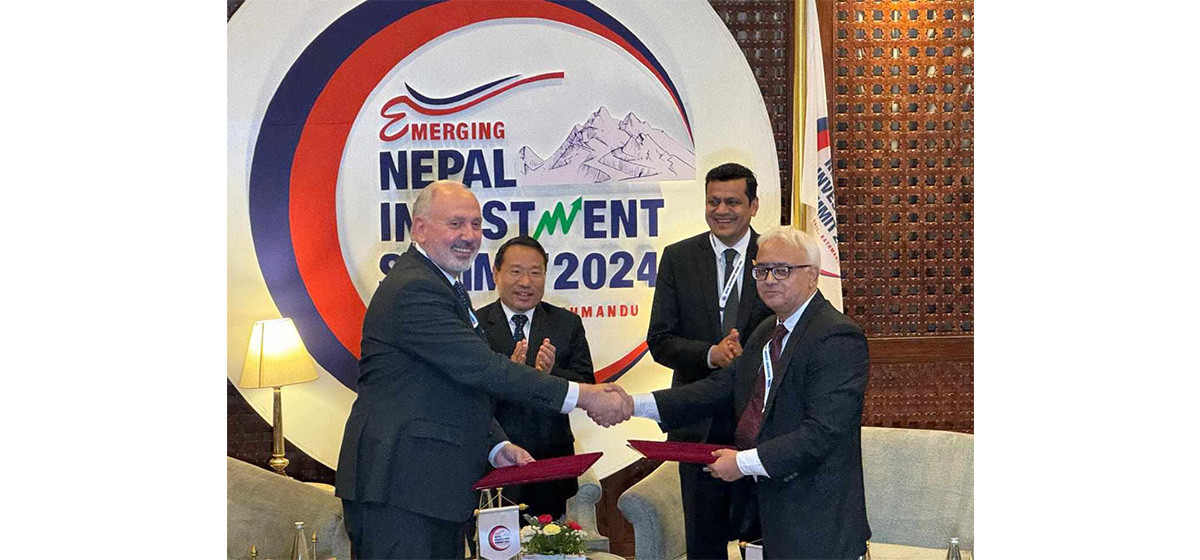

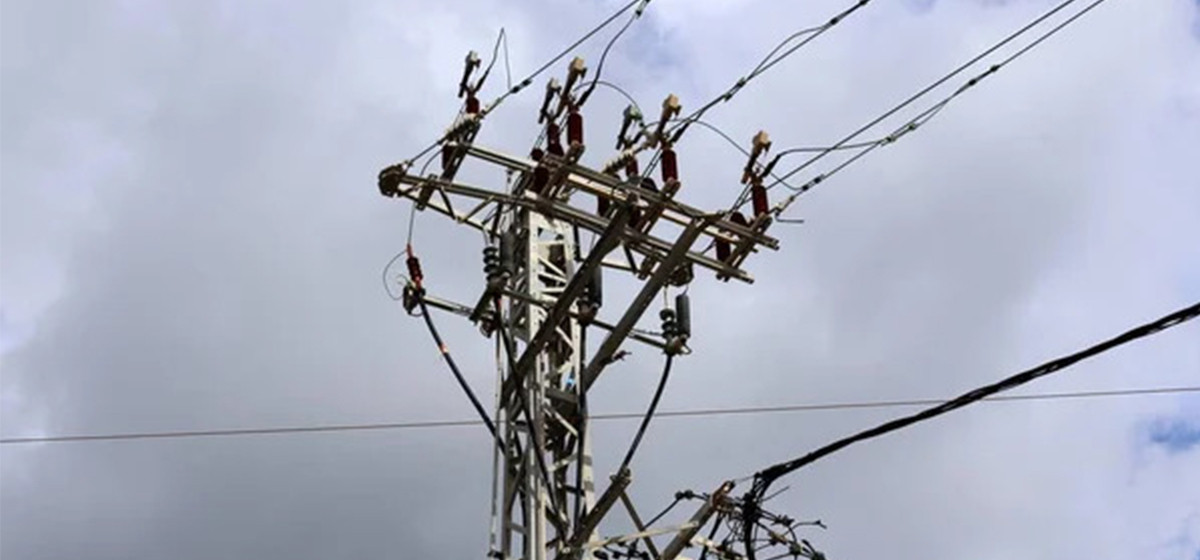
Leave A Comment